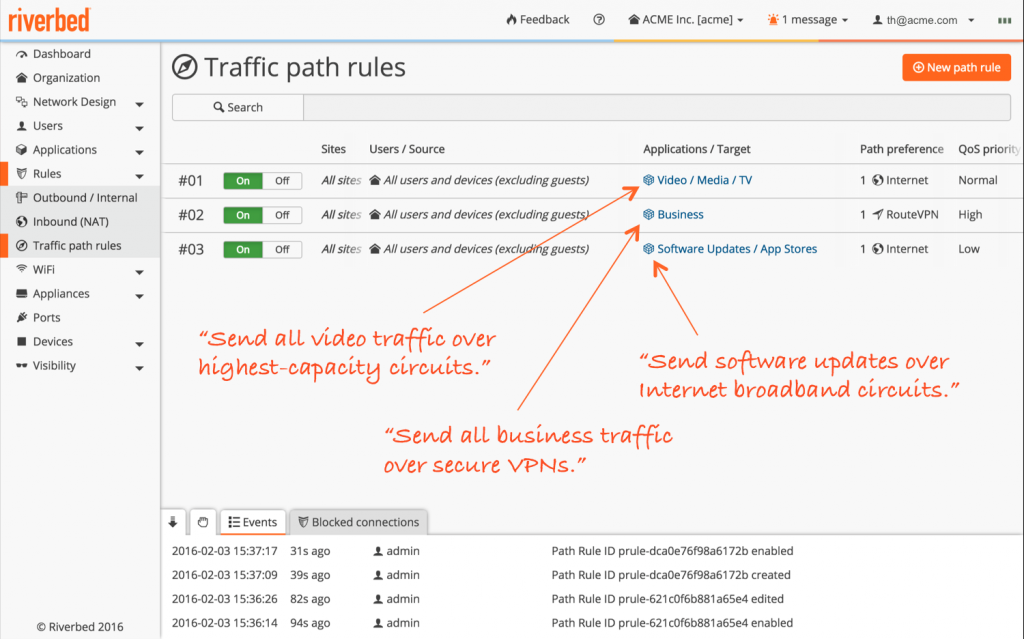The noise in the Software-Defined Wide-Area Networking (SD-WAN) marketplace has reached pandemonium levels, as a wide range of vendors seek to disrupt Cisco’s hegemony in the networking marketplace.
The reason why the SD-WAN space is so hot is because it represents disruptions at the conjunction of three separate areas: the WAN market, Cloud Computing, and the rapidly maturing Software-Defined Everything (SDX) arena.
One vendor in the SD-WAN market is Riverbed Technology, whose SteelConnect SD-WAN solution complements its popular SteelHead WAN Optimization offering. Now Riverbed is bringing those technologies together.
Breaking Down SD-WAN
Enterprises have been using wide-area networks (WANs) for decades, primarily to connect their remote offices or branches with their headquarters by leasing secure networking capabilities from telco carriers and running private networks over them. The underlying WAN protocols have evolved over the years, and the current one is Multiprotocol Label Switching (MPLS).
However, MPLS is now an older technology, and is more expensive than now-standard Internet broadband connections. Your home Internet may be both faster and cheaper than your company’s MPLS, the reasoning goes, so is the added security of a dedicated network over a leased line really worth the money?
The answer: it depends. For more sensitive or regulated traffic, MPLS may still be the technology of choice. But for many corporate uses, the Internet may be the more cost-effective option.
And then there’s the impact of the cloud. WAN is no longer simply about connecting one office to another. Today, every office must connect to various cloud services, from Salesforce to Microsoft Azure to Amazon’s AWS. MPLS simply doesn’t work well in such situations.
SD-WAN solves both of these problems. It gives companies the ability to leverage different network technologies (typically MPLS and broadband Internet) as a matter of policy. Instead of having to configure network hardware directly, SD-WAN centralizes administration of such networking policies, thus abstracting the underlying network.
That abstraction is at the core of SDX. Instead of having to configure and maintain any technology manually – from network equipment to servers and beyond – shift the control to centralized software. Now, if they need to adjust which traffic goes over which connection, or establish granular rules about who can leverage which services over which network, admins can configure and manage all such choices from a simple dashboard.
Riverbed’s Differentiation in the SD-WAN Market
Riverbed is an established player in the WAN optimization market with its flagship SteelHead devices. WANs have long required optimization because the long distances involved can lead to performance issues like latency and slowdowns. Riverbed has implemented innovative approaches for resolving such issues, and has a loyal customer base as a result.
With the more recent rollout of SteelConnect, Riverbed is now a significant player in the SD-WAN market as well. Yet, while SteelConnect offers a remarkable level of policy-based control via a highly usable dashboard, Riverbed’s competitors are also rolling out such features. Given the rapid innovation in this market combined with the number of vendors and the overall noise level,
Connecting SD-WAN to the Cloud
Cloud connectivity is a must-have for most SD-WAN customers, and is, in fact, one of the main reasons why SD-WAN has been such an explosive market. To address this need, Riverbed has recently added Microsoft Azure support to its existing Amazon AWS capabilities, allowing ‘single-click’ creation of SD-WAN capabilities in the two leading public cloud environments.
Furthermore, SteelConnect automates secure connectivity between cloud vendors, between cloud regions, as well as between corporate branch locations and the cloud. Riverbed also provides a unified management console for cloud, WANs, and local area networks (LANs) as well, as shown in the screenshot below.

Configuring Traffic Path Rules in SteelConnect Manager (Source: Riverbed Technology)
The power of this combination of capabilities is profound. With SteelConnect, admins can assign network, security, and cloud access policies to individuals regardless of where they are physically located or which network they are connected to.
For example, an employee based in the New York office can bring her laptop to the Singapore office, and she will have the same access to corporate on-premises and cloud services that she has at home, independent of how the Singapore network is configured.
From the business perspective, therefore, a network no longer consists of boxes, cables, and carrier-provided WAN connectivity. Instead, the network now connects people and the application resources they require – with central, flexible control and management of access and other security policies.
This business-centric vision is the vision of SDX, and is the reality of SD-WAN from vendors like Riverbed today.
Copyright © Intellyx LLC. Riverbed Technology is an Intellyx client. At the time of writing, none of the other organizations mentioned in this article are Intellyx clients. Intellyx retains full editorial control over the content of this paper.



